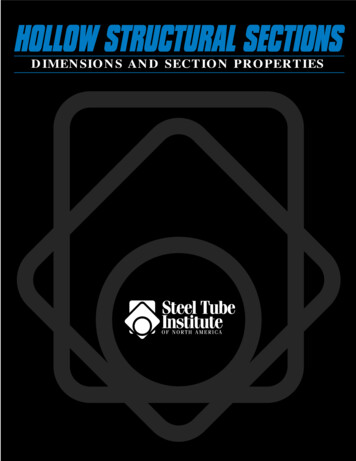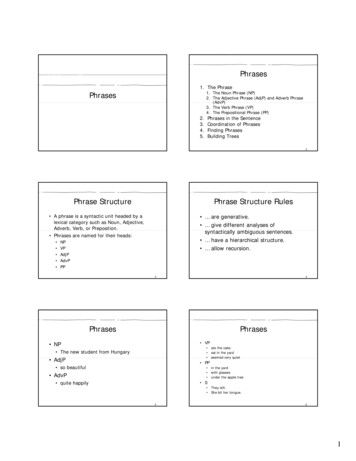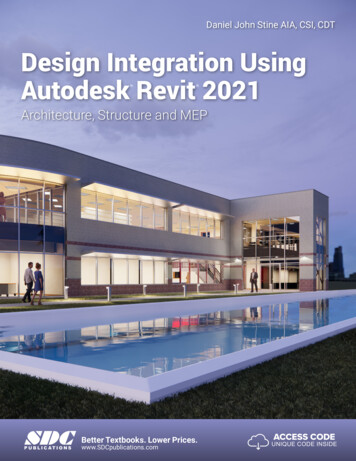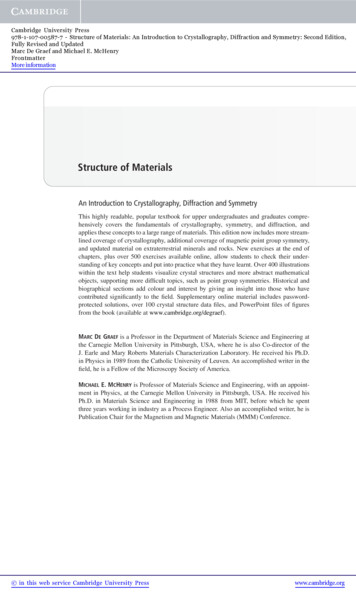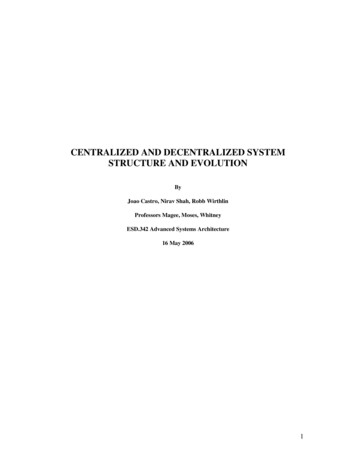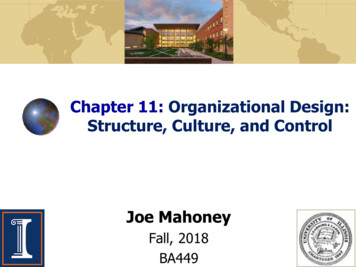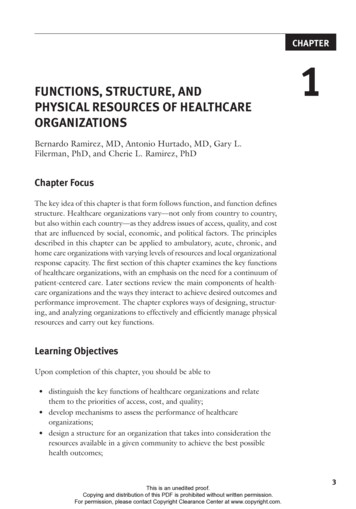
Transcription
Structure and Architecture
This Page Intentionally Left Blank
Structure and ArchitectureAngus J. MacdonaldDepartment of Architecture, University of EdinburghSecond editionArchitectural PressOXFORDAUCKLANDBOSTONJOHANNESBURGMELBOURNENEW DELHI
Structure and ArchitectureArchitectural PressAn imprint of Butterworth-HeinemannLinacre House, Jordan Hill, Oxford OX2 8DP225 Wildwood Avenue, Woburn, MA 01801-2041A division of Reed Educational and Professional Publishing LtdA member of the Reed Elsevier plc groupFirst published 1994Reprinted 1995, 1996, 1997Second edition 2001 Reed Educational and Professional Publishing Ltd 1994, 2001All rights reserved. No part of this publicationmay be reproduced in any material form (includingphotocopying or storing in any medium by electronicmeans and whether or not transiently or incidentallyto some other use of this publication) without thewritten permission of the copyright holder exceptin accordance with the provisions of the Copyright,Designs and Patents Act 1988 or under the terms of alicence issued by the Copyright Licensing Agency Ltd,90 Tottenham Court Road, London, England W1P 0LP.Applications for the copyright holder’s written permissionto reproduce any part of this publication should be addressedto the publishersBritish Library Cataloguing in Publication DataMacdonald, Angus J.Structure and architecture. – 2nd ed.1. Structural design. 2. Architectural designI. Title721ISBN 0 7506 4793 0Library of Congress Cataloguing in Publication DataA catalogue record for this book is available from the Library of CongressPrinted and bound in Great BritainComposition by Scribe Design, Gillingham, Kent
ContentsPreface viiAcknowledgements ix6.3 Reading a building as a structuralobject 676.4 Conclusion 71Introduction xi1 The relationship of structure to building 12 Structural requirements 92.1 Introduction 92.2 Equilibrium 92.3 Geometric stability 92.4 Strength and rigidity 152.5 Conclusion 213 Structural materials 223.1 Introduction 223.2 Masonry 223.3 Timber 253.4 Steel 303.5 Concrete 354 The relationship between structural formand structural efficiency 374.1 Introduction 374.2 The effect of form on internalforce type 374.3 The concept of ‘improved’ shapes incross-section and longitudinalprofile 404.4 Classification of structural elements 455 Complete structural arrangements 475.1 Introduction 475.2 Post-and-beam structures 485.3 Semi-form-active structures 555.4 Form-active structures 575.5 Conclusion 596 The critical appraisal of structures 606.1 Introduction 606.2 Complexity and efficiency in structuraldesign 607 Structure and architecture 737.1 Introduction 737.2 The types of relationship betweenstructure and architecture 737.3 The relationship between architectsand engineers 114Selected bibliography 124Appendix 1: Simple two-dimensional forcesystems and static equilibrium 128A1.1 Introduction 128A1.2 Force vectors and resultants 128A1.3 Resolution of a force intocomponents 129A1.4 Moments of forces 129A1.5 Static equilibrium and the equationsof equilibrium 129A1.6 The ‘free-body-diagram’ 132A1.7 The ‘imaginary cut’ technique 132Appendix 2: Stress and strain 134A2.1 Introduction 134A2.2 Calculation of axial stress 135A2.3 Calculation of bending stressA2.4 Strain 138135Appendix 3: The concept of staticaldeterminacy 140A3.1 Introduction 140A3.2 The characteristics of staticallydeterminate and staticallyindeterminate structures 140A3.3 Design considerations in relation tostatical determinacy 146Index 149
This Page Intentionally Left Blank
Preface to thesecond editionThe major theme of this book is therelationship between structural design andarchitectural design. The various aspects ofthis are brought together in the last chapterwhich has been expanded in this secondedition, partly in response to comments fromreaders of the first edition, partly because myown ideas have changed and developed, andpartly as a consequence of discussion of theissues with colleagues in architecture andstructural engineering. I have also added asection on the types of relationship which haveexisted between architects, builders andengineers, and on the influence which thesehave had on architectural style and form. Thepenultimate chapter, on structural criticism,has also been extensively rewritten. It is hopedthat the ideas explored in both of thesechapters will contribute to the betterunderstanding of the essential andundervalued contribution of structuralengineering to the Western architecturaltradition and to present-day practice.Angus J. MacdonaldDepartment of Architecture,University of EdinburghDecember 2000vii
This Page Intentionally Left Blank
AcknowledgementsAngus Macdonald would like to thank allthose, too numerous to mention, who haveassisted in the making of this book. Specialthanks are due to Stephen Gibson for hiscarefully crafted line drawings, Hilary Normanfor her intelligent design, Thérèse Duriez forpicture research and the staff of ArchitecturalPress (and previously Butterworth-Heinemann)for their hard work and patience in initiating,editing and producing the book, particularlyNeil Warnock-Smith, Diane Chandler, AngelaLeopard, Siân Cryer and Sue Hamilton.Illustrations other than those commissionedspecially for the book are individually creditedin their captions. Thanks are due to all thosewho supplied illustrations and especially toPat Hunt, Tony Hunt, the late Alastair Hunter,Jill Hunter and the staff of the picture librariesof Ove Arup & Partners, Anthony HuntAssociates, the British Cement Association, theArchitectural Association, the BritishArchitecture Library and the CourtauldInstitute.Thanks are also due most particularly tomy wife Pat, for her continuedencouragement and for her expert scrutiny ofthe typescript.ix
This Page Intentionally Left Blank
IntroductionIt has long been recognised that anappreciation of the role of structure isessential to the understanding of architecture.It was Vitruvius, writing at the time of thefounding of the Roman Empire, who identifiedthe three basic components of architecture asfirmitas, utilitas and venustas and Sir HenryWooton, in the seventeenth century1, whotranslated these as ‘firmness’, ‘commodity’ and‘delight’. Subsequent theorists have proposeddifferent systems by which buildings may beanalysed, their qualities discussed and theirmeanings understood but the Vitruvianbreakdown nevertheless still provides a validbasis for the examination and criticism of abuilding.‘Commodity’, which is perhaps the mostobvious of the Vitruvian qualities toappreciate, refers to the practical functioningof the building; the requirement that the set ofspaces which is provided is actually useful andserves the purpose for which the building wasintended. ‘Delight’ is the term for the effect ofthe building on the aesthetic sensibilities ofthose who come into contact with it. It mayarise from one or more of a number of factors.The symbolic meanings of the chosen forms,the aesthetic qualities of the shapes, texturesand colours, the elegance with which thevarious practical and programmatic problemsposed by the building have been solved, andthe ways in which links have been madebetween the different aspects of the design areall possible generators of ‘delight’.‘Firmness’ is the most basic quality. It isconcerned with the ability of the building to1 Wooton, H., The Elements of Architecture, 1624.preserve its physical integrity and survive inthe world as a physical object. The part of thebuilding which satisfies the need for ‘firmness’is the structure. Structure is fundamental:without structure there is no building andtherefore no ‘commodity’. Without welldesigned structure there can be no ‘delight’.To appreciate fully the qualities of a work ofarchitecture the critic or observer shouldtherefore know something of its structuralmake-up. This requires an intuitive ability toread a building as a structural object, a skillwhich depends on a knowledge of thefunctional requirements of structure and anability to distinguish between the structuraland the non-structural parts of the building.The first of these attributes can only beacquired by systematic study of those branchesof mechanical science which are concernedwith statics, equilibrium and the properties ofmaterials. The second depends on a knowledgeof buildings and how they are constructed.These topics are reviewed briefly in thepreliminary chapters of this book.The form of a structural armature isinevitably very closely related to that of thebuilding which it supports, and the act ofdesigning a building – of determining itsoverall form – is therefore also an act ofstructural design. The relationship betweenstructural design and architectural design cantake many forms however. At one extreme it ispossible for an architect virtually to ignorestructural considerations while inventing theform of a building and to conceal entirely thestructural elements in the completed versionof the building. The Statue of Liberty (Fig. ii) atthe entrance to New York harbour, which, giventhat it contains an internal circulation systemxi
Introductionof stairs and elevators, can be considered to bea building, is an example of this type. Thebuildings of early twentieth-centuryexpressionism, such as the Einstein Tower atPotsdam by Mendelsohn (Fig. iii) and somerecent buildings based on the ideas ofDeconstruction (see Figs 1.11 and 7.41 to 7.44)might be cited as further examples.All of these buildings contain a structure,but the technical requirements of the structurehave not significantly influenced the formwhich has been adopted and the structuralelements themselves are not importantcontributors to the aesthetics of thearchitecture. At the other extreme it is possibleto produce a building which consists of littleother than structure. The Olympic Stadium inMunich (Fig. i), by the architects Behnisch andPartners with Frei Otto, is an example of this.Between these extremes many differentapproaches to the relationship betweenstructure and architecture are possible. In the‘high tech’ architecture of the 1980s (Fig. iv), forexample, the structural elements discipline theplan and general arrangement of the buildingand form an important part of the visualvocabulary. In the early Modern buildings ofGropius, Mies van der Rohe, Le Corbusier (seeFig. 7.34) and others, the forms which wereadopted were greatly influenced by the types ofgeometry which were suitable for steel andreinforced concrete structural frameworks.Fig. i OlympicStadium, Munich,Germany, 1968–72;Behnisch & Partner,architects, with FreiOtto. In both the canopyand the raked seatingmost of what is seen isstructural. (Photo: A.Macdonald)xii
IntroductionFig. iii Sketches byMendelsohn of theEinstein Tower,Potsdam, Germany,1917. Structuralrequirements had littleinfluence on the externalform of this building,although they did affectthe internal planning.Surprisingly, it wasconstructed inloadbearing masonry.Fig. ii The thin external surface of theStatue of Liberty in New York Harbour, USA,is supported by a triangulated structuralframework. The influence of structuralconsiderations on the final version of theform was minimal.The relationship between structure andarchitecture can therefore take many forms andit is the purpose of this book to explore theseagainst a background of information concerningthe technical properties and requirements ofstructures. The author hopes that it will befound useful by architectural critics andhistorians as well as students and practitionersof the professions concerned with building.Fig. iv InmosMicroprocessor Factory,Newport, South Wales,1982; Richard RogersPartnership, architects;Anthony HuntAssociates, structuralengineers. The generalarrangement andappearance of thisbuilding were stronglyinfluenced by therequirements of theexposed structure. Theform of the latter wasdetermined by spaceplanning requirements.(Photo: Anthony HuntAssociates)xiii
This Page Intentionally Left Blank
Chapter 1The relationship ofstructure to buildingThe simplest way of describing the function ofan architectural structure is to say that it is thepart of a building which resists the loads thatare imposed on it. A building may be regardedas simply an envelope which encloses andsubdivides space in order to create a protectedenvironment. The surfaces which form theenvelope, that is the walls, the floors and theroof of the building, are subjected to varioustypes of loading: external surfaces are exposedto the climatic loads of snow, wind and rain;floors are subjected to the gravitational loadsof the occupants and their effects; and most ofthe surfaces also have to carry their ownweight (Fig. 1.1). All of these loads tend todistort the building envelope and to cause it toFig. 1.1 Loads on the building envelope. Gravitationalloads due to snow and to the occupation of the buildingcause roof and floor structures to bend and inducecompressive internal forces in walls. Wind causes pressureand suction loads to act on all external surfaces.collapse; it is to prevent this from happeningthat a structure is provided. The function of astructure may be summed up, therefore, asbeing to supply the strength and rigidity whichare required to prevent a building fromcollapsing. More precisely, it is the part of abuilding which conducts the loads which areimposed on it from the points where they ariseto the ground underneath the building, wherethey can ultimately be resisted.The location of the structure within abuilding is not always obvious because thestructure can be integrated with the nonstructural parts in various ways. Sometimes, asin the simple example of an igloo (Fig. 1.2), inwhich ice blocks form a self-supportingprotective dome, the structure and the spaceenclosing elements are one and the samething. Sometimes the structural and spaceenclosing elements are entirely separate. Avery simple example is the tepee (Fig. 1.3), inwhich the protecting envelope is a
building which satisfies the need for ‘firmness’ is the structure. Structure is fundamental: without structure there is no building and therefore no ‘commodity’. Without well-designed structure there can be no ‘delight’. To appreciate fully the qualities of a work of architecture the critic or observer should therefore know something of its structural make-up. This requires an .

